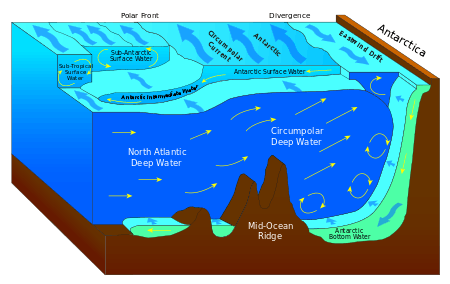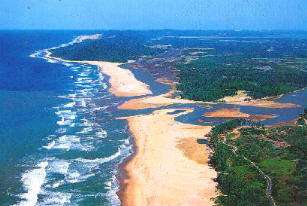Pelagic zone
The pelagic zone consists of the water column of the open ocean, and can be further divided into regions by depth. The word "pelagic" is derived from Ancient Greek πέλαγος (pélagos), meaning 'open sea'.[1] The pelagic zone can be thought of in terms of an imaginary cylinder or water column that goes from the surface of the sea almost to the bottom. Conditions in the water column change with distance from the surface (depth): the pressure increases; the temperature and amount of light decreases; the salinity and amount of dissolved oxygen, as well as micronutrients such as iron, magnesium and calcium, all change. Rather like the Earth's atmosphere, but depending on how deep the water is, the water column can be divided vertically into up to five different layers, as illustrated on the right.
| Marine habitats |
|---|
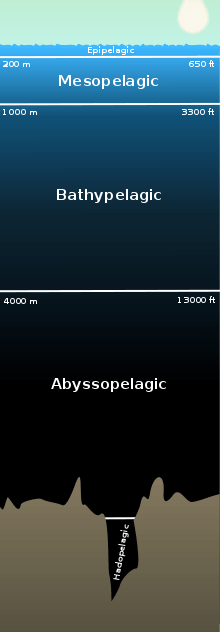 Scale diagram of the layers of the pelagic zone ---------------------------------------------------- |
In addition to the above changes, marine life is affected by bathymetry (underwater topography), by the proximity to land that is underwater such as the seafloor or a shoreline or a submarine seamount. Marine life is also affected by the proximity of the ocean surface, the boundary between the ocean and the atmosphere, which can bring light for photosynthesis but can also bring predation from above and wind stirring up waves and setting currents in motion. The pelagic zone refers to open and free waters in the body of the ocean that stretch between the ocean surface and the ocean bottom and are not too close to some boundary, like a shore or the seafloor or the surface. Marine life living in the pelagic zone can swim freely in any direction, unhindered by topographical constraints.
The oceanic zone is the deep open ocean beyond the continental shelf. These offshore waters contrast with the inshore or coastal waters near the coast, such as in estuaries or on the continental shelf. Waters can plunge in the oceanic zone to the depths of the abyssopelagic and even the hadopelagic. Coastal waters are generally confined to the relatively shallow epipelagic, though these are still pelagic waters providing they are not near the seafloor. Altogether, the pelagic zone occupies 1,330 million km3 (320 million mi3) with a mean depth of 3.68 km (2.29 mi) and maximum depth of 11 km (6.8 mi).[2][3][4] Fish that live in the pelagic zone are called pelagic fish. Pelagic life decreases with increasing depth.
The pelagic zone can be contrasted with the benthic and demersal zones at the bottom of the sea. The benthic zone is the ecological region at the very bottom of the sea. It includes the sediment surface and some subsurface layers. Marine organisms living in this zone, such as clams and crabs, are called benthos. The demersal zone is just above the benthic zone. It can be significantly affected by the seabed and the life that lives there. Fish that live in the demersal zone are called demersal fish, and can be divided into benthic fish, which are denser than water so they can rest on the bottom, and benthopelagic fish, which swim in the water column just above the bottom. Demersal fish are also known as bottom feeders and groundfish.
Depth and layers
Depending on how deep the sea is, the pelagic zone can extend to five vertical regions in the ocean. From the top down, these are:
Epipelagic (sunlight)
| Aquatic layers |
|---|
| Stratification |
| See also |
From the surface (MSL) down to around 200 m (660 ft)
This is the illuminated zone at the surface of the sea where enough light is available for photosynthesis. Nearly all primary production in the ocean occurs here. Consequently, plants and animals are largely concentrated in this zone. Examples of organisms living in this zone are plankton, floating seaweed, jellyfish, tuna, many sharks and dolphins.
Mesopelagic (twilight)
From 200 m (660 ft) down to around 1,000 m (3,300 ft)
The most abundant organisms thriving into the mesopelagic zone are heterotrophic bacteria.[5] Examples of animals that live here are swordfish, squid, Anarhichadidae or "wolffish" and some species of cuttlefish. Many organisms that live in this zone are bioluminescent.[6] Some creatures living in the mesopelagic zone rise to the epipelagic zone at night to feed.[6]
Bathypelagic (midnight)
From 1,000 m (3,300 ft) down to around 4,000 m (13,000 ft)
The name stems from Ancient Greek βαθύς, meaning 'deep'. At this depth, the ocean is pitch black, apart from occasional bioluminescent organisms, such as anglerfish. No living plant exists here. Most animals living here survive by consuming the detritus falling from the zones above, which is known as "marine snow", or, like the marine hatchetfish, by preying on other inhabitants of this zone. Other examples of this zone's inhabitants are giant squid, smaller squids and the grimpoteuthis or "dumbo octopus". The giant squid is hunted here by deep-diving sperm whales.
Abyssopelagic (abyssal zone)
From around 4,000 m (13,000 ft) down to above the ocean floor
The name is derived from Ancient Greek ἄβυσσος, meaning 'bottomless' (a holdover from the times when the deep ocean, or abyss, was believed to be bottomless). Very few creatures live in the cold temperatures, high pressures and complete darkness of this depth.[6] Among the species found in this zone are several species of squid; echinoderms including the basket star, swimming cucumber, and the sea pig; and marine arthropods including the sea spider.[6] Many of the species living at these depths are transparent and eyeless because of the total lack of light in this zone.[6]
Hadopelagic (hadal zone)
The name is derived from the realm of Hades, the Greek underworld. This is the deepest part of the ocean at more than 6,000 m (20,000 ft) or 6,500 m (21,300 ft), depending on authority. Such depths are generally located in trenches.
Pelagic ecosystem
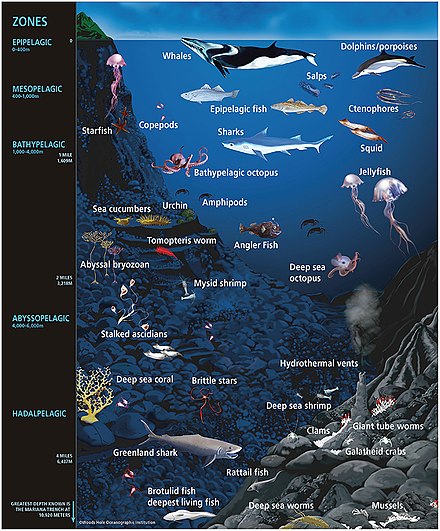
The pelagic ecosystem is based on phytoplankton. Phytoplankton manufacture their own food using a process of photosynthesis. Because they need sunlight, they inhabit the upper, sunlit epipelagic zone, which includes the coastal or neritic zone. Biodiversity diminishes markedly in the deeper zones below the epipelagic zone as dissolved oxygen diminishes, water pressure increases, temperatures become colder, food sources become scarce, and light diminishes and finally disappears.[8]
Pelagic invertebrates
Some examples of pelagic invertebrates include krill, copepods, jellyfish, decapod larvae, hyperiid amphipods, rotifers and cladocerans.
Thorson's rule states that benthic marine invertebrates at low latitudes tend to produce large numbers of eggs developing to widely dispersing pelagic larvae, whereas at high latitudes such organisms tend to produce fewer and larger lecithotrophic (yolk-feeding) eggs and larger offspring.[9][10]
Pelagic fish
Pelagic fish live in the water column of coastal, ocean, and lake waters, but not on or near the bottom of the sea or the lake. They can be contrasted with demersal fish, which live on or near the bottom, and coral reef fish.[11]
These fish are often migratory forage fish, which feed on plankton, and the larger fish that follow and feed on the forage fish. Examples of migratory forage fish are herring, anchovies, capelin, and menhaden. Examples of larger pelagic fish which prey on the forage fish are billfish, tuna, and oceanic sharks.
Pelagic reptiles
Pelamis platura, the pelagic sea snake, is the only one of the 65 species of marine snakes to spend its entire life in the pelagic zone. It bears live young at sea and is helpless on land. The species sometimes forms aggregations of thousands along slicks in surface waters. The pelagic sea snake is the world's most widely distributed snake species.
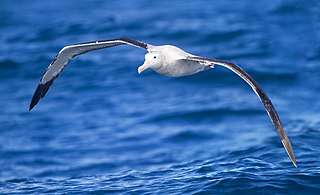
Many species of sea turtles spend the first years of their lives in the pelagic zone, moving closer to shore as they reach maturity.
Pelagic birds
Pelagic birds, also called oceanic birds or seabirds, live on open seas and oceans rather than inland or around more restricted waters such as rivers and lakes. Pelagic birds feed on planktonic crustaceans, squid and forage fish. Examples are the Atlantic puffin, macaroni penguins, sooty terns, shearwaters, and Procellariiformes such as the albatross, Procellariidae and petrels.
References
- pelagic (adj.) Online Etymological Dictionary. Retrieved 17 February 2020.
- Costello, Mark John; Cheung, Alan; De Hauwere, Nathalie (2010). "Surface Area and the Seabed Area, Volume, Depth, Slope, and Topographic Variation for the World's Seas, Oceans, and Countries". Environmental Science & Technology. 44 (23): 8821–8. Bibcode:2010EnST...44.8821C. doi:10.1021/es1012752. PMID 21033734.
- Charette, Matthew; Smith, Walter (2010). "The Volume of Earth's Ocean". Oceanography. 23 (2): 112–4. doi:10.5670/oceanog.2010.51. hdl:1912/3862.
- Ocean's Depth and Volume Revealed OurAmazingPlanet, 19 May 2010.
- Mazuecos, E.; Arístegui, J.; Vázquez-Domínguez, E.; Ortega-Retuerta, E.; Gasol, J.M.; Reche, I. (2012). "Temperature control of microbial respiration and growth efficiency in the mesopelagic zone of the South Atlantic and Indian Oceans". Deep Sea Research Part I: Oceanographic Research Papers. 95: 131–138. doi:10.3354/ame01583.
- The Open Ocean - MarineBio.org
- Apprill, A. (2017)"Marine animal microbiomes: toward understanding host–microbiome interactions in a changing ocean". Frontiers in Marine Science, 4: 222. doi:10.3389/fmars.2017.00222.

- Walker P and Wood E (2005) The Open Ocean (volume in a series called Life in the sea), Infobase Publishing, ISBN 978-0-8160-5705-4.
- Thorson, G (1957). "Bottom communities (sublittoral or shallow shelf)". In Hedgpeth, J.W. (ed.). Treatise on Marine Ecology and Palaeoecology. Geological Society of America. pp. 461–534.
- Mileikovsky, S. A. (1971). "Types of larval development in marine bottom invertebrates, their distribution and ecological significance: a re-evaluation". Marine Biology. 10 (3): 193–213. doi:10.1007/BF00352809.
- Lal, Brij V.; Fortune, Kate (January 2000). The Pacific Islands: An Encyclopedia. University of Hawaii Press. p. 8. ISBN 978-0-8248-2265-1.
Further reading
- Ryan, Paddy "Deep-sea creatures" Te Ara – the Encyclopedia of New Zealand, updated 21 September 2007
- "Pelagic-zone (oceanography)" Encyclopædia Britannica Online. 21 March 2009.
- Grantham HS, Game ET, Lombard AT, et al. (2011) "Accommodating Dynamic Oceanographic Processes and Pelagic Biodiversity in Marine Conservation Planning" PLOS One 6(2): e16552. doi:10.1371/journal.pone.0016552.
- Wrobel, David; Mills, Claudia (2003) [1998]. Pacific Coast Pelagic Invertebrates: A Guide to the Common Gelatinous Animals. Sea Challengers and Monterey Bay Aquarium. ISBN 0-930118-23-5.

